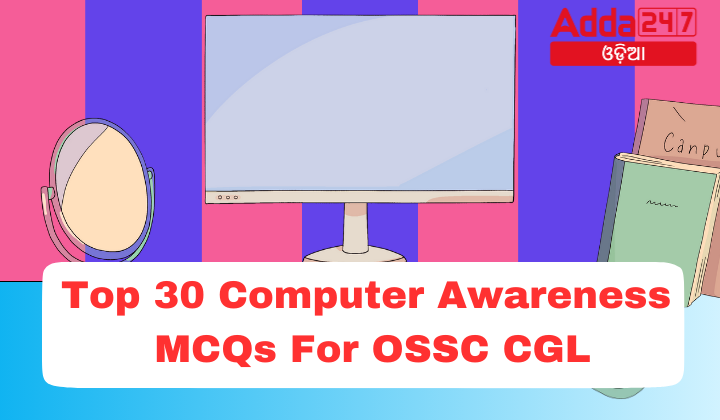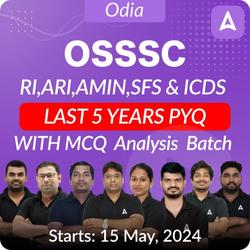Prepare for the OSSC CGL with these Top 30 Computer Awareness MCQs, designed to enhance your knowledge. Covering fundamental concepts in computing, from hardware to software and beyond, these questions aim to sharpen your understanding and boost your confidence. Whether you’re familiarizing yourself with basic terminology or delving into more advanced topics, this curated set ensures comprehensive preparation. Master concepts like operating systems, networking, and data structures, vital for success in the OSSC CGL examination. Elevate your computer awareness proficiency and ace the test with ease.
Top 30 Computer Awareness MCQs For OSSC CGL
- Which of the following devices was used in the first generation of computers?
A) Transistors
B) Integrated Circuits
C) Vacuum Tubes
D) Microprocessors
Answer: C) Vacuum Tubes - Which language was predominantly used in first-generation computers?
A) Assembly Language
B) Machine Language
C) FORTRAN
D) COBOL
Answer: B) Machine Language - What was the main technology used in the second generation of computers?
A) Vacuum Tubes
B) Transistors
C) Integrated Circuits
D) Microprocessors
Answer: B) Transistors - Which of the following is an example of a second-generation computer?
A) IBM 7094
B) ENIAC
C) UNIVAC
D) IBM 360
Answer: A) IBM 7094 - The third generation of computers used which of the following technologies?
A) Transistors
B) Vacuum Tubes
C) Integrated Circuits
D) VLSI Microprocessors
Answer: C) Integrated Circuits - Which was the first computer to use integrated circuits?
A) IBM 7094
B) IBM 360
C) UNIVAC
D) Apple II
Answer: B) IBM 360 - In which period were third-generation computers developed?
A) 1946-1959
B) 1959-1965
C) 1965-1971
D) 1971-1980
Answer: C) 1965-1971 - What does VLSI stand for in the context of the fourth generation of computers?
A) Very Large Scale Integration
B) Variable Large Scale Integration
C) Various Large Scale Integration
D) Volatile Large Scale Integration
Answer: A) Very Large Scale Integration - Which computer is an example of the fourth generation?
A) ENIAC
B) PDP
C) CRAY-X-MP
D) IBM 1620
Answer: C) CRAY-X-MP - Which company developed the first microprocessor?
A) IBM
B) Intel
C) AMD
D) Motorola
Answer: B) Intel - Which generation of computers is based on artificial intelligence?
A) First Generation
B) Second Generation
C) Fourth Generation
D) Fifth Generation
Answer: D) Fifth Generation - What technology is used in fifth-generation computers?
A) Vacuum Tubes
B) Transistors
C) Integrated Circuits
D) ULSI Microprocessors
Answer: D) ULSI Microprocessors - The IBM 360 is an example of which generation of computers?
A) First Generation
B) Second Generation
C) Third Generation
D) Fourth Generation
Answer: C) Third Generation - What is a key feature of fifth-generation computers?
A) Use of vacuum tubes
B) Artificial Intelligence
C) Use of transistors
D) Punch cards
Answer: B) Artificial Intelligence - In which generation did personal computers (PCs) become popular?
A) First Generation
B) Second Generation
C) Third Generation
D) Fourth Generation
Answer: D) Fourth Generation - Which of the following is an example of a fifth-generation computer?
A) Apple II
B) IBM 7094
C) Intel P 4
D) IBM 360
Answer: C) Intel P 4 - The period of the fourth generation of computers is:
A) 1946-1959
B) 1959-1965
C) 1965-1971
D) 1971-1980
Answer: D) 1971-1980 - Which programming languages are used in fifth-generation computers?
A) Machine Language
B) Assembly Language
C) COBOL and FORTRAN
D) Python, Java, C#
Answer: D) Python, Java, C# - What was a major drawback of the first-generation computers?
A) Slow processing speed
B) Low electricity consumption
C) Compact size
D) High multitasking ability
Answer: A) Slow processing speed - Which of the following computers was developed during the first generation?
A) IBM 1620
B) PDP
C) ENIAC
D) IBM 370
Answer: C) ENIAC - What is a computer virus?
a) A hardware component
b) A piece of code that gets implanted in a program and can self-replicate
c) A type of software update
d) A type of network protocol
Answer: b) A piece of code that gets implanted in a program and can self-replicate - Which of the following can indicate a computer virus infection?
a) Faster system performance
b) Absence of pop-up ads
c) Files and applications opening by themselves
d) Increased storage space
Answer: c) Files and applications opening by themselves - How can a computer virus spread?
a) Through secure links only
b) By running antivirus software
c) Via email attachments, downloaded files, and software installations
d) Through hardware components
Answer: c) Via email attachments, downloaded files, and software installations - What type of virus affects the boot sector of a computer?
a) Direct Action Virus
b) Boot Sector Virus
c) Resident Virus
d) Macro Virus
Answer: b) Boot Sector Virus - What is the main characteristic of a Direct Action Virus?
a) It installs itself in the primary memory
b) It overwrites the boot sector
c) It connects itself directly to a .exe or .com file
d) It changes its code with each infection
Answer: c) It connects itself directly to a .exe or .com file - Which type of virus is known to alter its code each time it infects a new file?
a) Multipartite Virus
b) Polymorphic Virus
c) Macro Virus
d) Overwrite Virus
Answer: b) Polymorphic Virus - What is the function of antivirus software?
a) Increase the speed of the internet
b) Detect and remove viruses and other malicious software
c) Update the operating system
d) Enhance graphics performance
Answer: b) Detect and remove viruses and other malicious software - What is the main goal of a Multipartite Virus?
a) Infect only the boot sector
b) Infect multiple parts of the system, including program files and boot sector
c) Replace all system files
d) Enhance system security
Answer: b) Infect multiple parts of the system, including program files and boot sector - Which type of virus is hard to detect because it fills the empty spaces of a file without changing its size?
a) File Infector Virus
b) Resident Virus
c) Spacefiller Virus
d) Browser Hijacker
Answer: c) Spacefiller Virus - How does antivirus software typically work?
a) By deleting all files on the computer
b) By downloading malware definitions and scanning files for matches
c) By improving the computer’s processing power
d) By installing hardware components
Answer: b) By downloading malware definitions and scanning files for matches










